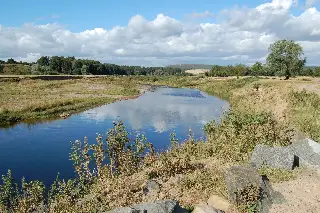Greetings from the Byways & Bridleways Trust…
Due to the rather shy and retiring nature of the BBT most of our success stories slip into history without comment. Well, what purpose is there in winning a battle that benefits the wider rights of way using community at large if those rights of way users do not hear of it.
When you are weary, the last thing you want is to have to wade or swim a river, rather than crossing by means of a bridge. The Byways & Bridleways Trust welcomes a commonsense decision about the diversion of a public footpath in Northumberland, and believes that it will have a valuable effect on the usability of bridleways.

In 2007, Northumberland County Council made an order to change a cluster of public rights of way at Hedgeley Northumberland, including diverting Footpath 1 from where it currently crosses the River Breamish, which is notorious for running ‘high and fast’ at times. Anyone looking at this crossing point today would be excused for thinking that it is, and always has been, virtually impassable, with no proper ford, and steep banks.
But it was not always like this. When Footpath 1 went on to the definitive map and statement of public rights of way in the early 1950s, it crossed the river by means of a footbridge, which ‘disappeared’, allegedly in the 1980s. In its statutory notice accompanying the package of changes, Northumberland County Council said that Footpath 1 “… will ford the River Breamish and is usable when river levels are
low.”
Local walker and cyclist Alan Kind objected to the council’s proposal. He said that the crucial test to be applied is that in section 119(6) of the Highways Act 1980: “… the diversion effected by the path or way will not be substantially less convenient to the public in consequence of the diversion …” ‘Wading through a river, when low enough to allow this, cannot be other than ‘substantially less convenient’ than a footbridge, and the absence of the bridge is just a ‘temporary circumstance’ that must be discounted’, said Kind.
In her decision letter, the Secretary of State’s Independent Inspector, Mrs Sue Arnott agrees, and writes, “I have to agree that this is the crux of the matter … I conclude that I must make the comparisons between the relative convenience of existing and proposed routes on the basis that users are entitled to walk Footpath 1 crossing the river by a footbridge … the alternative route … via the new ford … cannot be other than substantially less convenient when, at best, it would mean crossing with wet feet.” Mrs Arnott also disagrees with the council’s assertion that few people would walk Footpath 1 were the bridge to be reinstated.
The Trust welcomes this pragmatic view and looks forward to the restoration of this excellent, and too-long-unusable, public footpath. This decision will be influential on other councils proposing unsatisfactory river-crossing diversions of bridleways and footpaths.
Comments (6)
Leave Reply
Post Comment

So, a new bridge on a footpath. Is this an invitation to cheekyness?
A bike isn’t an accessory to walking.
You have to tie one end of a piece of rope to a rock, and then tie the other end to your bike. Then you throw the rock over the river, walk over the bridge then pull your bike across the river.
Otherwise you will go to hell.
maybe I’m being thick but what does the judgement mean and how does it benefit bikers?
mlke – all developments are good, and assuming its this bridge, its right next to a bridleway, so opens up good route possibilities.
Doh!
this bridge
“maybe I’m being thick but what does the judgement mean and how does it benefit bikers?”
It means that the council have a duty to replace the missing bridge thus restoring a public right of way to its original usable state. Whilst this particular instance may be on a Footpath, its relevance to cyclists is that a precedent has been made which could be applied to other Rights of Ways, eg. Bridleways and Byways, in other similar cases.